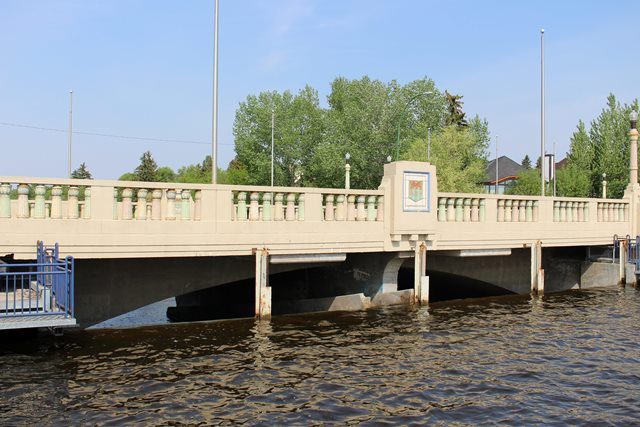We Recommend:
Bach Steel - Experts at historic truss bridge restoration.
Albert Memorial Bridge

Primary Photographer(s): C. Hanchey, CC BY-NC 2.0, flickr.com/photos/21953562@N07/
Bridge Documented: May 27, 2015
Regina: Division 6 (Regina), Saskatchewan: Canada
1930 By Builder/Contractor: Carter-Halls-Aldinger Company and Engineer/Design: Claude Allen Porter Turner of Minneapolis, Minnesota and Puntin, O'Leary and Coxall
Not Available or Not Applicable
72.0 Feet (21.9 Meters)
843.0 Feet (256.9 Meters)
Not Available
1 Main Span(s)
Not Applicable

View Information About HSR Ratings
Bridge Documentation
This unusual bridge has a small main span and a long approach and is noted for its association with famous engineer C. A. P. Turner. It was opened in 1930 and dedicated as a memorial to the Saskatchewan soldiers who died in World War I. The Albert Memorial Bridge is the third at the location. It's construction was part of a larger project during the Great Depression, which also included draining and dredging the adjacent Wascana Lake, and building two islands in the lake. The pastel-colored terracotta balusters were inspired by the interest shown in the discovery of King Tut's Tomb in 1923. The bridge was rededicated in 1988 following a restoration project. The Albert Memorial Bridge was recognized as a Municipal Heritage Property in 1984 (MHP 392) and was listed on the Canadian Register of Historic Places in 2006. Notes from provincial heritage bridge inventory: "Albert Memorial Bridge"; current Municipal Heritage Property; depression-era relief project; mushroom-head, flat-slab design by historically-significant Minneapolis consulting engineer, Claude A.P. Turner; similar to the “Moose Jaw Viaduct” of the same period, but more ornate.
Information and Findings From Canada's Historic PlacesDescription of Historic Place The Albert Memorial Bridge is a Municipal Heritage Property located on Albert Street, a main north-south throughway in Regina. Constructed in 1930, the property features a 256-metre long bridge spanning the Wascana Creek. Heritage Value The heritage value of Albert Memorial Bridge lies in
its association with the public relief programs started in response to
the Great Depression. The economic depression that followed the stock
market crash in 1929 had a tremendous impact on Saskatchewan. Funded
jointly by the federal, provincial and municipal governments, the Albert
Memorial Bridge was constructed in 1930 as part of a relief project that
employed 700 men. On November 10, 1930 the ornate bridge was dedicated
to the province’s fallen soldiers of World War I, making it the first
war memorial commissioned by the provincial government. Situated on
Regina's main north-south throughway, the Albert Memorial Bridge serves
as a gateway to Wascana Park, the Old Lakeview area and the downtown
core. It is reputed to be the longest bridge spanning the shortest body
of water in the world. Character-Defining Elements The heritage value of the Albert Memorial Bridge
resides in the following character-defining elements: Heritage Designation and Type: Yes |
![]()
Photo Galleries and Videos: Albert Memorial Bridge
Bridge Photo-Documentation
Original / Full Size PhotosA collection of overview and detail photos. This gallery offers photos in the highest available resolution and file size in a touch-friendly popup viewer.
Alternatively, Browse Without Using Viewer
![]()
Bridge Photo-Documentation
Mobile Optimized PhotosA collection of overview and detail photos. This gallery features data-friendly, fast-loading photos in a touch-friendly popup viewer.
Alternatively, Browse Without Using Viewer
![]()
Maps and Links: Albert Memorial Bridge
Coordinates (Latitude, Longitude):
Search For Additional Bridge Listings:
Additional Maps:
Google Streetview (If Available)
GeoHack (Additional Links and Coordinates)
Apple Maps (Via DuckDuckGo Search)
Apple Maps (Apple devices only)
Android: Open Location In Your Map or GPS App
Flickr Gallery (Find Nearby Photos)
Wikimedia Commons (Find Nearby Photos)
Directions Via Sygic For Android
Directions Via Sygic For iOS and Android Dolphin Browser

